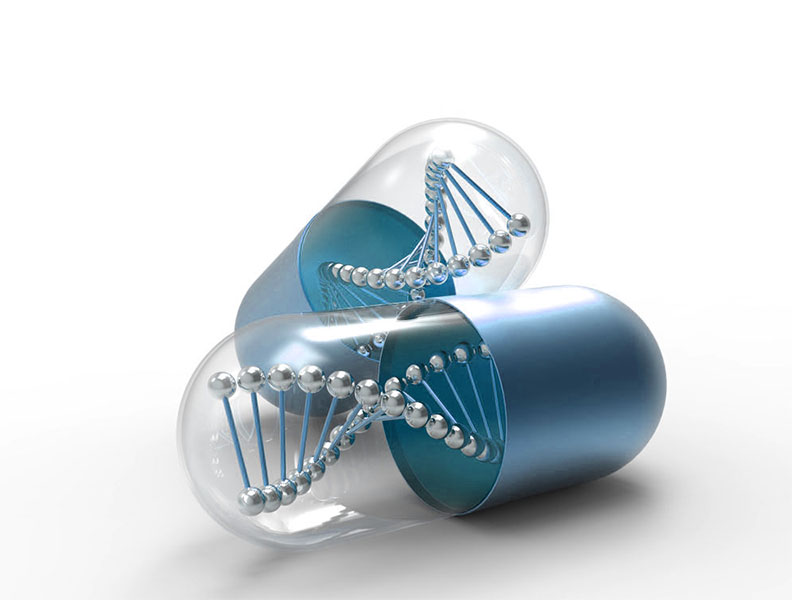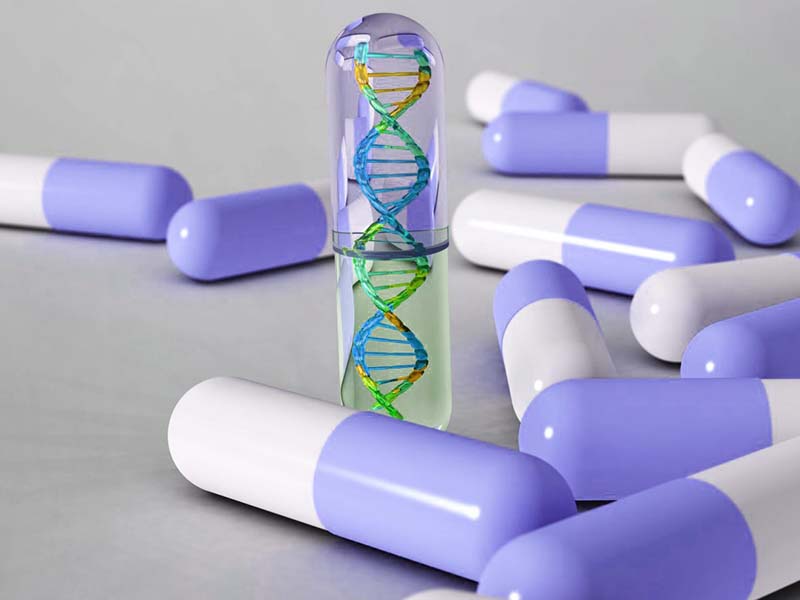There is a growing demand for biologics owing to clinical success, favorable safety data, and the ability of biologics to target the underlying causes of disease. Advances in proteins, peptides, nucleic acids, vaccines, and monoclonal antibodies (mAbs) have enabled rapid development of biopharmaceuticals, especially in recent years. According to an article in Molecules, 25 percent of new drugs approved by the FDA between 2015 and 2019 were biologics. Perhaps the most dramatic recent example of demand for biologics is the rapid scale-up and application of messenger RNA (mRNA) vaccines against COVID-19. Despite rapid progress, various challenges have posed obstacles to global adoption due to complications related to formulation, thermal stability, and drug delivery.

Biopharmaceuticals are derived from living organisms, have large molecular weights, and generally cannot be chemically synthesized. This means they are susceptible to environmental influences and require extra care in formulation, production and storage. Since biopharmaceuticals are usually large molecules with primary, secondary, tertiary and quaternary structures, their production is also sensitive and expensive. Although biologics are usually delivered intravenously in liquid form, liquid formulations exhibit chemical and physical stability issues. Conversely, biopharmaceuticals formulated as dry powders are more stable and less prone to degradation, but drug manufacturers must consider shelf-life stability and which excipients and formulation conditions can extend shelf-life. In addition, the chemical and physical properties of the final product must be considered during formulation to suit the route of administration.
Part1 Overcoming The Challenges Of Oral Biologics
A major problem with respiratory and lung diseases treated by oral therapy is that lower amounts of drug reach the lungs while higher amounts are delivered systemically, which reduces effectiveness and leads to potentially life-threatening toxicity. Vaccines are one such example of a biologic drug that can offer significant advantages and circumvent the challenges of oral delivery when it is delivered directly to the respiratory system rather than via systemic injection. The lung has a larger surface area and a thinner peripheral epithelium, so administering the vaccine directly to this area can work more quickly. In addition, the stimulation of mucosal surfaces by inhalation of vaccines directly into the respiratory system is an advantage for immunity as it triggers memory T cell immune responses at the site of infection, allowing for faster neutralization of the virus and as a preventive strategy for infectious diseases .
While the administration of respiratory drugs, including vaccines, is a potential avenue to overcome the challenges of oral administration, vaccine formulations have their own challenges that require appropriate development, manufacturing, distribution, and storage considerations. Although vaccines are usually refrigerated between 2-8 ˚C, ideally they should be stored at ambient temperature with a long shelf life to reduce the cost of storage and distribution. Sensitive vaccines, such as mRNA vaccines, require cooler temperatures to remain active. However, vaccines in liquid form cannot be frozen, as this process stresses the mixture and can cause irreversible changes in protein shape and function. Common vaccine adjuvants, such as aluminum salts, also cannot be frozen and require expensive cold chain storage for distribution. Excipients and other stabilizers can improve the stability of liquid vaccines, but reformulation through dry powders offers a more “elegant” solution.
Dry powder formulations can improve thermal stability, avoiding or reducing cold-chain storage requirements; improve aerosol properties for direct-to-lung or nasal delivery; and provide greater flexibility for convenient routes of administration, all at a lower Dosing is performed, thereby improving safety and efficacy. Nebulizers and metered dose inhalers deliver drugs in liquid form, which exposes biologics to harsh conditions and lead to longer dosing times for patients, while dry powder formulations can be administered intranasally and/or with standard inhalers Administration after reconstitution.
However, it is not an easy task to convert biopharmaceuticals into dry powder. To maintain activity and potency, biopharmaceuticals must retain their physical and chemical structure, which poses challenging formulation issues. There is an unmet need for formulation and delivery technologies to manufacture biopharmaceuticals with aerosolization properties while maintaining structural integrity and stability for improved drug delivery of biopharmaceuticals. Addressing this need could transform the field of pharma and improve the course of care for the millions of patients treated with biologics.
Part 2 Current Technology Of Dry Powder Development
Studies have shown that dry powder properties facilitate aerodynamic delivery to the lungs and other areas, including highly porous surface areas and small, submicron and micron-sized particles. However, depending on the form of the drug, physical and chemical degradation may occur during the drying process, so the choice of technique must be carefully considered. Technologies for producing inhalable pharmaceutical powders include:
Spray drying (SD), or spraying the solution into dry hot air. This can be used to produce inhalation products, but is mainly limited to small molecules and proteins that are not sensitive to heat.
Nanomilling is one of the most common processes to increase the bioavailability of poorly soluble drugs. The process involves wet milling or dispersing particles by impact to mechanically reduce particle size and increase surface area, and has desirable properties for oral, parenteral and inhalational drug delivery. Increasing the surface area increases the rate of dissolution and, therefore, bioavailability, but conditions can be harsh.
Shelf freeze-drying (shelf FD)/lyophilization is a common process for producing stable protein pellets and dry powder vaccines. The process involves using a freeze dryer called a lyophilizer to freeze a liquid drug and sublimate the solvent until it forms a powder. A disadvantage of shelf FD is that the powder must be further processed by grinding to improve particle size and surface area. Unfortunately for proteins, this induces mechanical stress leading to degradation, uneven particle size distribution and low yields of expensive biopharmaceuticals. Despite this challenge, shelf FD has been used almost exclusively for temperature-sensitive products, but the process can take days, complicating production and distribution.
Spray freeze drying (SFD) combines the advantages of freeze drying and conventional spray drying to produce highly porous particles, which are advantageous for inhalation. The SFD process involves spraying an aqueous solution through a high-pressure nozzle into a cold gas stream above liquid nitrogen. The resulting powder has a high surface area, and the droplet shape and size can be tailored through a variety of atomizing nozzles and spray rates. Some of the limitations are large phase-liquid interfaces and shear stress, which lead to challenges in formulating proteins. In addition, atomizing liquids through high-pressure nozzles can lead to degradation and loss of activity of surfactant proteins.

Spray freezing into a liquid (SFL) involves spraying a liquid formulation directly into liquid cryogen, a substance used to generate extremely low temperatures. This has a slower freezing rate than SFD, resulting in a smaller surface area, which improves stability by reducing the risk of water adsorption. Protein powder produced by SFL has better properties than SFD, including less adsorption, aggregation and denaturation, and higher enzyme activity.
Of note, SFD, SFL, and shelf FD all avoid the use of heat that may denature proteins. Despite the advantages of these technologies, the properties of powders produced by SFD, SFL, and shelf FD may not be suitable for inhalation, especially for biopharmaceuticals, because these technologies can cause aggregation – the abnormal association of proteins into larger aggregate structures – leading to activity loss.
Part 3 Thin Film Freezing And Improved Delivery Of Biopharmaceuticals
Thin-film freezing, an advanced formulation process that produces stable protein particles of submicron size, is potentially ideal for overcoming some of the challenges described above. The process can be described as the following steps:
Drugs with or without inactive ingredients (excipients) are dissolved in solvent systems. The product is applied to a cryogenically cooled surface, usually a stainless steel drum. This rapid freezing results in the formation of a frozen film. The cryosolvent system is removed by sublimation and the powder is collected in high yield – almost 100% compared to 80% for SFD. Powders are processed into drugs for targeted delivery by inhalation, intranasal administration, reconstituted injection, or topically to the skin or eyes.
Originally developed to improve poorly water-soluble drugs, thin-film freezing has shown unique advantages over other low-temperature technologies used to prepare biopharmaceuticals, forming unique particle characteristics that facilitate inhalation. The powder is porous, has a high surface area and low density, and can be aerosolized to facilitate delivery to the lungs, nose and eyes. Thin-film freezing has a similar cooling rate to SFL but can form high surface area particles, which is advantageous for inhalation therapy. In addition, the cooling rate can be more easily controlled. Thin-film freezing has also been shown to preserve protein stability and bioactivity and reduce denaturation compared to other techniques.
Thin-film freezing is particularly convenient for the development of vaccine formulations. Dry powder vaccines containing aluminum salts formulated using film freezing did not show aggregation after reconstitution after repeated freezing and thawing. Thin-film freezing also preserves drug activity after high-temperature storage. The immunogenicity of the thin film lyophilized powder vaccine was maintained after storage at storage temperatures up to 40 ˚C for up to three months.
Thin-film cryotherapy is being applied to a variety of therapies, including biologics, currently in preclinical and clinical development, and is relevant for respiratory therapy, as it allows for faster onset of action and fewer systemic side effects, thereby targeting the lungs to deliver therapy . One application where thin film cryotechnology could offer significant advantages is the use of dry powder mAbs for COVID-19. Thin film freezing has been shown to produce better mAb aerosol properties compared to shelf FD, and the dry powder version of mAb tested in vivo successfully neutralized SARS-CoV-2 infection and reduced viral load. Delivery of thin-film lyophilized COVID-19 antibodies to infected hamsters resulted in a dose-dependent reduction in viral load when dosing began 24 hours after infection with SARS-CoV-2. Thin-film freezing has also been used to improve the delivery of abiotic antiviral therapies for COVID-19, including remdesivir and niclosamide, and may offer a promising alternative to outpatient COVID-19 treatment.
Part 4 The Future Of Biologics Delivery
Lessons learned in recent years, including in the rapid deployment and production of mRNA vaccines for the prevention of COVID-19, have made evident the need for innovative technologies to optimize drug formulation, delivery, stability, dosing, and distribution. Process methods and excipients must be considered for different routes of administration in order to develop properties that overcome biological barriers and improve drug delivery. Non-invasive therapies that are stable at room temperature could eliminate the need for ultra-cold chain storage and reduce logistics costs, making medicines more readily available globally. More targeted delivery of biologics could also improve the efficacy of these therapies, especially for respiratory diseases.

Although dry powder formulations offer a logical solution to overcome the challenges of liquid delivery of biopharmaceuticals, not all conventional dry powder technologies are suitable for the formulation and delivery of biopharmaceuticals. Thin film freezing has emerged as a promising particle engineering technique for the development of dry drug powders, which overcomes the challenges of other technologies in terms of temperature stability, water solubility, and absorption. Thin-film freezing has been successfully applied to prepare dry powders of proteins and biopharmaceuticals, which maintain their structure and functional activity, have optimal aerosol performance and improved thermal stability, overcoming the limitations of cold-chain storage. Other dry powder technologies are emerging, including the use of microwave energy as a sublimation heat source for uniform drying, and LyoSphere, which forms beads for easy dispensing. The industry is also investigating other processes, such as sterile spray freeze drying, aseptic spray drying, and radiant energy vacuum, in an effort to overcome formulation and manufacturing challenges for biopharmaceuticals
As researchers continue to advance biologics to treat disease, further developments in dry powder technology will be critical to expanding and improving the delivery of these therapies to better support patient accessibility, convenience, and efficacy.










